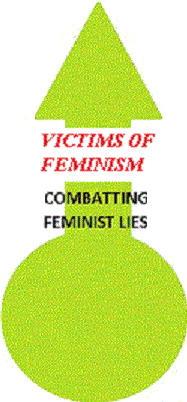Home > Issues > Sexual Abuse and Child Abuse > Sexual Abuse by Women |
||||||||||

|
Empowering Men:fighting feminist lies |
|||||||||
Sexual Abuse by Women
© Peter Zohrab 2011 |
||||||||||
(See, for example, Margaret Dodds 'attracted to pre-pubescent boys)
Introduction
The Women's Movement is a lobby group for women, and Feminism is a research and public relations industry devoted to blaming and punishing men and allowing women to do whatever they want without fear of negative consequences. Meanwhile, feminists point to all the men in decision-making positions as proof that women are disadvantaged. These men in decision-making positions, however, have mostly achieved those positions by embracing feminism and/or chivalry -- i.e. by oppressing men and privileging women. Therefore, pointing to the number of men in decision-making positions as evidence of male domination is a scam, known as the Frontman Fallacy. In Western countries, at least, the vast majority of men favour women over men in their decisions, because they have been taught that men oppress women, and they want to show that they are different from all those imaginary, awful, male-chauvinist men!
Therefore, it is not surprising that the hysteria drummed up by feminists around the topic of sexual abuse of children has concentrated on male perpetrators. As Denov (2004, pp. 1-2) points out, "between 1976 and 1985, reports of sexual abuse in the United States rose eighteenfold." This was the result of feminists drawing attention to the issue. However, it is women who spend vastly more unsupervised time in private with children, and who therefore have vastly more opportunity to commmit sexual abuse of children.
Here are some quotes from a book on female sex offending, with my comments in brackets):
1. "... the training that I received in both social work and criminology had never mentioned or even insinuated that women could be perpetrators of sexual abuse." (Yet another example of anti-male bias in universities).
2. "Many of the professionals I consulted not only questioned whether it was possible for a woman to commit a sexual offence, but also questioned whether sexual abuse by a woman would be harmful to the victim." (Yet another example of anti-male bias amongst professionals, such as psychologists).
3. "... victims frequently spoke of negative experiences that they had had upon disclosing female perpetrated sexual abuse to helping professionals." (Yet another example of anti-male bias amongst professionals, such as psychologists).
4. "several social service organisations refused my request to display a poster to recruit potential participants claiming that the topic of female sex offending was 'anti-feminist'...." (Yet another example of anti-male bias amongst professionals and the state-funded voluntary sector).
5. "I was hung up on by several psychiatrists who did not want to discuss the issue. (Yet another example of anti-male bias amongst professionals, such as psychologists and psychiatrists).
6. "... my panel of academic assessors began to laugh and make derogatory comments when I began to discuss males who were sexually abused by females." (Yet another example of anti-male bias in universities).
These quotes are from pages ix - x of the book by Myriam S. Denov, entitled "Perspectives on Female Sex Offending: A Culture of Denial", 2004, Aldershot, England: Ashgate.
The Problem
After these preliminary remarks on the feminist, anti-male culture which dominates what we laughingly call "academia" and the "professions", Denov goes on to discuss her substantive findings. For example, she found (ibid, p. 70) that, in the Police, "Training appeared to focus exclusively on sexual assault as a crime committed by males (sic) perpetrators against female victims." That being the case, the ordinary police officer is hardly likely to take seriously allegations of sexual assault levelled at females.
Denov (2004, p. 79) also shows how female suspects are treated differently:
Within police discourse, there appeared to be three common techniques used to render the female sex offender as 'harmless'.... First, ... the offender's acts were absolved by affirming that there was no malicious intent.... Second, she was portrayed as not dangerous and posed no threat to the community .... Finally, the circumstances surrounding the sexual offence were reconstructed and it was the victim who was held responsible for the incident....
As regards the culture of denial, Denov (2004, p. 175) states:
For police officers, psychiatrists and victims, the challenge posed by female sex offending evokes varying degrees of conflict and discomfort as it threatens the security of the traditional model of the world. To alleviate the discomfort, these three groups, either unwittingly or fully aware, transformed sexual offences by women. They appeared to invoke a gendered lens, a lens whereby the offender's gender became central to the meaning of the offence.
and, further (ibid, p. 176):
... the enactment of the transformation process ultimately led to the denial of female sex offending.
Denov describes the hostility of the feminist Establishment towards any attention being paid to female sex offending, stating (2004, p. 184):
In essence, the mere existence of a lone woman who sexually abuses children appears to invalidate feminist explanations of sexual assault, underminig the core aspect of feminist theory -- patriarchy and its role in the subordination of women.
Conclusion
Denov (2004, p. 3) states that "There is little doubt that males commit the vast majority of sexual offences and their victims are predominantly female." However, given what she herself says about the experiences that victims have upon disclosing female perpetrated sexual abuse (see above), and the Culture of Denial which is part of the title of her book, it is impossible for anyone to state this with any certitude. Denov herself (2004, p. 9) states that "there is evidence to suggest that sexual abuse by females may be under-recognized."
This book is thorough and well-written, and I recommend also: Hannah Ford: "Women Who Sexually Abuse Children", 2006, Chichester: John Wiley.
|
|
|||||||||
|
|||||||||
Top |